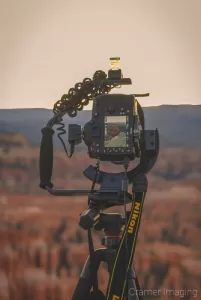10 Questions to Ask Before Taking a Commercial Art Commission
Shop

Are you an artist about to meet with a client and embark upon your first commercial art commission? How exciting! It feels really good to receive that kind of validation. Or, maybe you’ve already completed a few commissions and you’re looking to tighten up your process. Now, do you know what to ask during the initial conversation? The information gleaned from this initial conversation is crucial to you completing the commission properly. Just in case you need some help, I’ve got 10 questions you should ask before taking on a commercial art commission.
1.What is the Client’s Vision/Need Regarding This Project?
Every client and every project has different needs. Some projects are about marketing a business, product, or service. Others are about featuring a founder, manager, or other staff member. Still others are about a particular blog post or article. You get the idea. You need to know what the final vision is for this project so you can properly do your job.

Not every client you work will be able to clearly articulate their vision. In such cases, you must prepare yourself with a list of probing questions designed to help crystalize the vision for you. Based upon their answers, you will gain an idea of what exactly they want and whether or not you can adequately meet that need. Take this list of sample prompts.
- Please describe how you envision the final image(s). What do(es) it/they include and what do(es) it/they omit?
- Do you want color or black and white (if relevant to your medium)?
- What is not included in the scope of this project?
Make sure that you create a list of questions you need the client to answer in order for you to complete their order. As you’re already familiar with your medium(s) of choice, you already know a few questions to ask. Think about it for a bit if nothing immediately comes to mind.

A note of caution: occasionally you’ll find a client who wants you to duplicate another’s work. Take care when accepting such assignments. If they want you to duplicate Van Gogh (or someone else’s work already in public domain), then you’re probably in the clear if you want to accept the assignment. If the client wants you to duplicate something still protected by copyright, then I recommend you pass. Such assignments can land you in lots of legal trouble. See this article on copyright infringement for more details.
2. Does the Client Have a Design Brief?

Many established companies have a design brief for marketers and content creators to follow. This design brief will contain things like brand colors and fonts, target audience demographics and psychographics, schedule, budget, and more. In fact, a properly-written design brief should answer most if not all of your questions.
If the client has a design brief, then you should follow the information contained therein. Doing so will give you your best chance of creating a happy customer at the end of the project. Since this is a commercial art commission, then others will see your quality of work. If you do well enough, you might land other work from the job.
If the client does not have a design brief, then you might consider encouraging them to generate one for you. However, the smaller the company, the less time the owners and employees might have to create such. You might need to proceed without one. Just make sure that you know exactly where and what you’re supposed to do and not supposed to do. After all, a design brief is not required but does help simplify things.
3. What is the Timeline of the Project?

Every project you accept has a timeline. So, you need to know the timeline for this particular project. After all, you need a delivery date for your client. That being said, most commercial art commissions are connected to another larger project such as a marketing campaign or a new website launch. So you will need to work around that schedule if you accept the commission.
If you’re accepting a multi-faceted project, then you may encounter several different due dates for different parts of the project. Also, you may need to schedule different photo shoots or other steps around other people’s schedules. You need to know this kind of information up front that way you can make the timeline work for you. After all, tight timetables require lots of frantic work and dedicated focus. Looser timetables grant more flexibility.
Another issue you may encounter is that the timeline of the project might conflict with something else you have going. Perhaps you’re in another project and the timelines conflict. Maybe you’re taking personal time and the project timeline interferes with your activities there. In such instances, it’s acceptable to turn down a commercial art project if you cannot fulfill the timeline requirements.
4. Does the Client Want Preliminary Designs or WIP Updates?
Some clients want to wait until the end of your work to see what you created. Others, the more discerning clients, want to see work in progress (WIP). They may request preliminary design ideas and sketches to approve before you fully start into the project. In taking this step, the client feels more involved and they also keep you on the right track as an artist. It may be your work as an artist, but it’s the client’s vision which they’re paying you to fulfill.
 As this is a commercial art commission, then you might rightly feel a desire to charge for such steps in the process. Some clients will be willing to compensate you for your extra efforts there. Others will consider such preliminary work as part of the total negotiated price. Still, you need to address this point during price discussion. If not, you might be in for a shock later when you and your client disagree on a payment timetable.
As this is a commercial art commission, then you might rightly feel a desire to charge for such steps in the process. Some clients will be willing to compensate you for your extra efforts there. Others will consider such preliminary work as part of the total negotiated price. Still, you need to address this point during price discussion. If not, you might be in for a shock later when you and your client disagree on a payment timetable.
Not every commercial art commission will allow for preliminary design approval. Take photography as an example. While I could take a test shot or 2 and send those in for approval, that’s hardly worth the client’s time and energy. It’s far better for me to go take the photos I need and submit final photos for approval. I can re-edit if I need to. By the way, I’ve had clients ask me to re-edit my photos to better fit their vision before. Still, where you can, send work-in-progress updates or preliminary sketches for approval. It’ll make your commercial art project go much smoother overall.
In this vein, keep in mind that you need to set some limits. Set a lower and an upper boundary for how many WIPs you’ll offer. This will allow you the freedom and time you need to complete the work while still keeping the client in the loop. Choose strategic points where you can easily correct things if the client feels you’re going off course. That way you won’t be overwhelmed with progress updates but the client still feels involved. Also, you complete the project according to the timeline agreed upon.
5. Travel Expectations. Who’s Paying?
Now, let’s start things off with this statement. Not every commercial art commission will require you to travel. However, some will. If you’re a photographer taking a commercial project, for example, you might need to travel. If you’re a painter hired to paint something specific, you might need to travel if photos won’t do. But not every artist needs to travel to complete a commissioned project. So this may or may not apply to you as an artist. Gauge this from your initial conversation discussing subject matter.

Now, that being said, if travel is an important part of your project, then you must discuss who’s paying for your travel expenses. For small and VERY local projects, you might not need travel compensation. However, a proper client will pay you for your efforts there. If you’re looking at traveling a significant distance, especially with high fuel and airfare prices, then the client should pay for your travel expenses. This is especially true if your travel expenses will exceed the entire amount you’ll receive from this commission. If a client wishes to avoid compensating your travel, then that’s a good sign that that the client will create other headaches down the road. Don’t accept such a project. You can’t afford such a cheap client long-term.

I have an example of this myself. Once, I received a call from a prospective commercial client who thought I might vacation in the area (paying my own travel expenses) and they might toss me a couple hundred dollars for my work WHILE I’m on vacation. I wasn’t interested in vacationing there and I would spend many hours working on shooting and editing this potential job. My billable hours would easily total over $200 worth. Needless to say, we did not come to an agreement. I did not do the project. Watch out for commercial and private commissions like this. You’ll really regret it if you do accept such a project.
Now, on your end, you must be reasonable in your travel expectations. Don’t expect to travel first-class, rent a Ferrari, or guzzle the minibar. Don’t expect 5-star accommodations or restaurants either. Keep your travel expenses reasonable. Smart clients will provide a travel budget. Do your best to stay within that budget. Then you’ll have a very happy customer at the end of the project. Happy customers often become repeat customers and send others your way as well.
6. Where and When Will this Commercially Commissioned Work Appear?
This should easily find its way onto your list of required questions. If a client wants to commission a commercial art project from you, then you need to know where and how they plan to display it. This will help you meet several requirements right off. Also, it gives you a better idea of what to properly charge for your time and effort.

Here we have a section where we discuss specifically where your art will appear. What website(s), social media, print media, parts of the world, etc. will they use? How long do they plan to use it for? As the copyright owner, you can set a time limit, location limit, etc. on how the client can use your art. If the client purchases the copyright from you (get that in writing), then they can do what they want to.

As you know, social media platforms have their own requirements for visual media. Each profile image and banner image require specific dimensions. Each platform limits how large an image file may be when uploaded. If your prospective client wants to use your art on social media, ask which platform(s). Take down a list. Then you can meet the requirements each platform sets. Private websites are more flexible than social media accounts but still may have minimum requirements for clarity on screen.

Now, let’s look at something much more flexible. Let’s look at print media forms. As you know, images displayed on websites and printed in magazines, books, flyers, brochures, newspapers, and more are much less constrained in size requirements. Still, you can ask about things like print runs. This tells you how many times they plan on printing your art.
With this information, you can set your prices properly. You can license things for 1 Facebook account (list the account name), 1 website (list the url) for 6 months in Auckland New Zealand if you so choose. Also, you can license your art for the cover of a 500 book run of a new book publication with a specific publishing company. Each display area is an opportunity to negotiate licensing prices. Don’t get greedy, but don’t let the client walk all over you either. Sign a legally binding contract with all of these terms included. Remember that you can expand, extend, add addendums, and more later as necessary. Also, make a point of discussing (and getting in writing) who owns the copyright. It’ll save headaches later.
7. What Design Elements are Required?
Now, your client may allow you to interpret and improvise on a particular theme or idea. Still, you must make sure before you start as some clients will come to you with specific requirements for you to include in your art. These requirements may include things like a watermark or logo. There may be specific text to include. You get the idea. Make sure to ask about this before you start into the project. Otherwise, you might end up marring your finished product with a logo or other design element you didn’t plan for. Setbacks and disappointments because of unclarified expectations will not land you a happy customer. Make this question an essential question on your list.

8. What Size and Medium?
 If you create physical art, then you should naturally ask about the art size. After all, you need to know how big or small to make the commercial art commission. You don’t want to make something too big for the display space. Also, you don’t want to make it too small either. You need the right balance and your client is the one to give that information to you.
If you create physical art, then you should naturally ask about the art size. After all, you need to know how big or small to make the commercial art commission. You don’t want to make something too big for the display space. Also, you don’t want to make it too small either. You need the right balance and your client is the one to give that information to you.
If you also happen to pursue more than 1 art medium, make sure to clarify which medium(s) the client wants. You’d think it’d be obvious but that’s a trap. Clarify this so there’s no mix-ups. You wouldn’t want to start into a massive photo project only to learn that the client wanted a painting or a sketch instead, or vice versa. I know artists who pursue more than 1 medium of art. Get all of this information in writing as well.
9. What Technical Requirements for Digital Files?
If you’re more of a digital artist or graphic designer, then you face a few other questions. You need to know the technical specifications your client requires. These include things like file size, file type, number of images, number of megapixels, pixel dimensions, and more.
 Keep in mind that pixel density matters too. Web elements can get away with 72 dpi (dots per inch). However, most print mediums require no less than 300 dpi for a seamless image. If you attempt to send less, then the print image will probably pixelate.
Keep in mind that pixel density matters too. Web elements can get away with 72 dpi (dots per inch). However, most print mediums require no less than 300 dpi for a seamless image. If you attempt to send less, then the print image will probably pixelate.
Can you imagine delivering a final product in an .indd format when the client needs a .png? You need specialized software to open an .indd file. The client probably won’t have access to such. Png’s are much more universally accepted. How about delivering a .bmp when the client needs a .jpeg? How about sending the client an image too small to work with the rest of their project? Do you get the idea? You might need to re-submit your final work in the proper format. Also, you’ll have an unhappy customer who needed to request a resend. Mistakes happen, even in final delivery. Still, your client shouldn’t need to worry about this part of the process.
10. What is the Budget?
 This is a very important question to ask. Oftentimes, it’s a pivotal question which helps determine whether or not you take the job. We’re talking about a commercial art commission here. You should expect proper compensation for making the client look good. Still, you also need to know what you’re looking at. If the pay is reasonable, then you might consider accepting the job. If not, then you might consider passing up the job. However, I don’t recommend leading with this question. Get a feel for the job itself and then lead the discussion around to budget when it feels natural to do so.
This is a very important question to ask. Oftentimes, it’s a pivotal question which helps determine whether or not you take the job. We’re talking about a commercial art commission here. You should expect proper compensation for making the client look good. Still, you also need to know what you’re looking at. If the pay is reasonable, then you might consider accepting the job. If not, then you might consider passing up the job. However, I don’t recommend leading with this question. Get a feel for the job itself and then lead the discussion around to budget when it feels natural to do so.
Remember that travel budget addressed above? Make sure you discuss travel budget as a part of your overall budget. Perhaps travel expenses are included in the total price. Perhaps they’re a separate budget altogether. Still, discuss this part in your overall budget negotiations if travel expenses are relevant to this project.
This is also where you discuss copyright transfer fees and licensing fees. If the client wishes for either of these options, make a point of discussing everything necessary. Also, make sure that the client knows things like if you charge a license fee per social media account the client displays your art on. If they want to add another account later, then they know upfront that it will cost them extra to add the license. Being clear and upfront like this during budget negotiations will save you so many headaches later on. After-the-fact pricing shocks, like this example social media license fee, often lead to angry customers who will not return and may also do worse things like leave poor reviews.

Also, take care during budget negotiations. Appearing too eager or desperate will not help you in the end. It places the power of money squarely in the client’s hands and some clients will run with that power. They may low-ball you and stick to their guns that way. Be prepared to walk away from low-ball offers and make that fact known even if things sound great otherwise. Your willingness to pass may just incentivize the client to up the budget offer. However, do keep in mind that a lack of interest may just lose you the commercial art commission. Attempting to negotiate an inflexible budget might just result in the same thing. There are other interested artists out there too.
Nail down your project budget AND get it in writing BEFORE you start on the project. This will save you so many headaches later on.
Conclusion
In conclusion, there are several points which you must discuss with a prospective client bringing you a commercial art commission. If you ask these strategic questions before you embark upon the project, you will find yourself better prepared for the work ahead of you. You’ll find yourself empowered to create the best work of art to represent your client commercially that you can. In fact, you’ll also save yourself countless headaches after-the-fact. You’ll walk away from the project with a wallet full of money and a happy customer.
In the end, it’s totally up to you as an artist why you choose to accept or reject a potential commercial art commission project. However, these questions will help you decide if a potential project is the right project for you.
Best Sellers
Cramer Imaging Newsletter

Receive monthly updates in your inbox from us.






